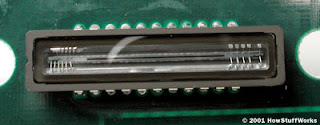•Flatbed scanners, also called desktop scanners, are the most versatile and commonly used scanners. In fact, this article will focus on the technology as it relates to flatbed scanners.
•Sheet-fed scanners are similar to flatbed scanners except the document is moved and the scan head is immobile. A sheet-fed scanner looks a lot like a small portable printer.
•Handheld scanners use the same basic technology as a flatbed scanner, but rely on the user to move them instead of a motorized belt. This type of scanner typically does not provide good image quality. However, it can be useful for quickly capturing text.
•Drum scanners are used by the publishing industry to capture incredibly detailed images. They use a technology called a photomultiplier tube (PMT). In PMT, the document to be scanned is mounted on a glass cylinder. At the center of the cylinder is a sensor that splits light bounced from the document into three beams. Each beam is sent through a color filter into a photomultiplier tube where the light is changed into an electrical signal.
The basic principle of a scanner is to analyze an image and process it in some way. Image and text capture (optical character recognition or OCR) allow you to save information to a file on your computer. You can then alter or enhance the image, print it out or use it on your Web page.
Anatomy of a Scanner
Parts of a typical flatbed scanner include:
•Charge-coupled device (CCD) array
•Mirrors
•Scan head
•Glass plate
•Lamp
•Lens

•Cover
•Filters
•Stepper motor
•Stabilizer bar
•Belt
•Power supply
•Interface port(s)
•Control circuitry
The core component of the scanner is the CCD array. CCD is the most common technology for image capture in scanners. CCD is a collection of tiny light-sensitive diodes, which convert photons (light) into electrons (electrical charge). These diodes are called photosites. In a nutshell, each photosite is sensitive to light -- the brighter the light that hits a single photosite, the greater the electrical charge that will accumulate at that site.

The image of the document that you scan reaches the CCD array through a series of mirrors, filters and lenses. The exact configuration of these components will depend on the model of scanner, but the basics are pretty much the same.
...to be continued
*article from howstuffworks.com

No comments:
Post a Comment